I’m frequently asked how I produce my ethereal botanical and nature photography, so I thought I would do my best to explain some of my process and why I am drawn to shoot in this style. I’m a self-taught photographer so please forgive me if I can’t find the right vocabulary at times in this article. I’ve been drawn to using a soft and dreamy quality for my nature photography over the years in an attempt to convey the sense of peace and enhanced wellbeing that I feel when in the woods or meadows in the local countryside immersed in nature. In the stillness of focusing my lens on a flower or an insect, there is a feeling of communion that lifts me from the noisy human world of constant chatter and anxieties and envelops me in a language older than words.

I am far from alone in seeking solace in nature to help ease mental and physical health issues and like many others, the time I have spent immersed in the local landscape has given me the space, healing and perspective to deal with difficult times. Nature photography has developed from a method of recording species into a meditation practice for me. In meditation the practitioner seeks to dissolve the ego and its constant chatter and connect to a universal consciousness beyond the confines of the self. When focusing my lens upon a flower or insect, I experience that sense of losing the self and the feeling of separation between myself and the subject softens and blurs. Looking at the world through this lens of perception I see my encounters with nature as meetings with and not observations of, and the scientist in me gives way to the artist. This is why I am drawn to present my subjects in an ethereal way.

Shooting for soft focus and bokeh
Before I start to explain how I go about making my images, I should introduce my kit. I have an old Sony A58. It’s suffering a little from excessive use and love now and the rear screen and autofocus rarely work, so this limits how I can use my camera. I shoot nearly everything with a Tamron f2.8 90mm macro lens but do own a few old Helios and Minolta lenses which stop down to f1.4. I would love to experiment with other equipment and cameras as it is likely that better results may be achieved with better kit.
I take much of my photography in the middle of the day, a time that many photographers find the light to be harsh, but I like to let as much sunlight in as possible. Where the position of my subject will allow, I will always shoot into the light. And if it’s the middle of the day then I will very often be shooting from the ground looking directly upwards (this can be challenging when photographing butterflies. I will have the aperture as wide open as my lens will allow without blowing out the whites completely.

The burnt tip orchids above were growing on a slope, so I positioned myself under them and looked up, shooting through the foliage to produce the soft bokeh in the foreground. By using a selective focus and very shallow depth of field, I’m able to keep the subject in sharp focus and blur out the rest of the picture. I shoot in live view and never use the autofocus for portraits of flowers as part of the experience is the manual manipulation of what I can see through the viewfinder.

Shooting through foliage and into the sun also creates beautiful abstract botanical bokeh. I find using manual focus helps compose an image that maximises this effect. Firstly, pick out your subject from the tangle of the undergrowth and focus in on it. Then, sometimes shifting the angle of the lens or your position slightly, the bokeh in the image comes to life. As I use a macro, I tend to be about a yard or two from my subject whilst shooting in this way.
If it looks as though the whites in the image are going to blow out then waiting for the light to change, a cloud to pass by or adjusting my position slightly so I am shooting through different foliage can help to prevent this.
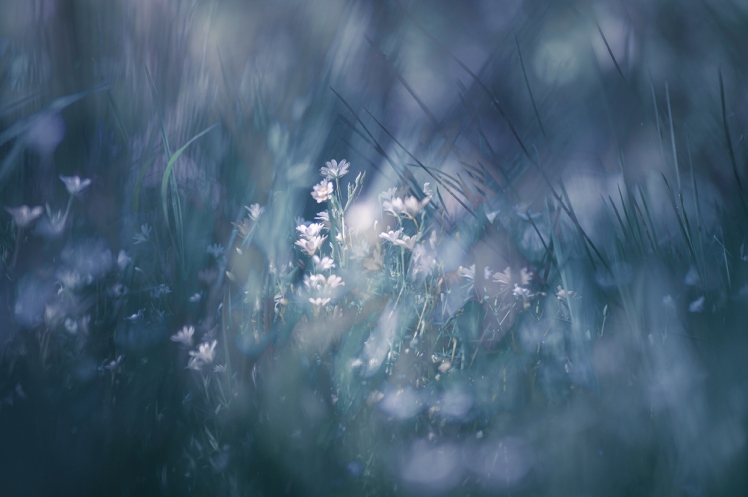
The image of greater stitchwort above was taken though grasses, which provide the soft bokeh at the front of the image. Shooting into the dappled light coming through the trees is what created the boken in this background. When taking images like this, I often rest the camera on the ground and pivot it up slightly. This is when your adjustable rear screen is your best friend, but as I’ve broken mine this is why if you bump into me in the woods, I will be wearing mud and twigs.

The softness in the poppy image above was created by shooting though a fallen petal that I had found on the ground. I often employ this technique to soften an image and the improvised natural filter also has the same tones that are in the subject.

A final note on shooting in nature, is to always leave the site as you found it. All my images are taken from footpaths. Many wild flowers are now in decline and some suffer negatively from the impacts of trampling and crushing. If shooting in an arable field, stick to the edges to avoid damaging crops which are someone’s livelihood. The headlands, margins and hedgerows are also where you are likely to find many interesting subjects.

The marbled white butterfly above is a common sight in the field margins here in Dorset, and shooting through a haze of ox eye daisies gave me the soft bokeh in the image above. With the small blue below, the very shallow depth of field separated the subject from the tangle of vegetation.

Post processing
I have always been drawn to muted and cooler tones, and my work over the years reflects this. In part I think this is because I have visual stress and dyslexia and find it hard to look at bright colours, especially yellows and oranges. But I also think this colour pallet better expesses how my emotions are calmed and thoughts uncluttered when in communion with the subjects of my photography. I usually tone down the vibracy the yellows and oranges in any image and bring out the blues, greys and violets. I use Lightroom, Photoshop, Nik Analogue Pro and Camera Raw to post process my pictures. The panels I like to create of collections from walks or of single subjects are created in InDesign.
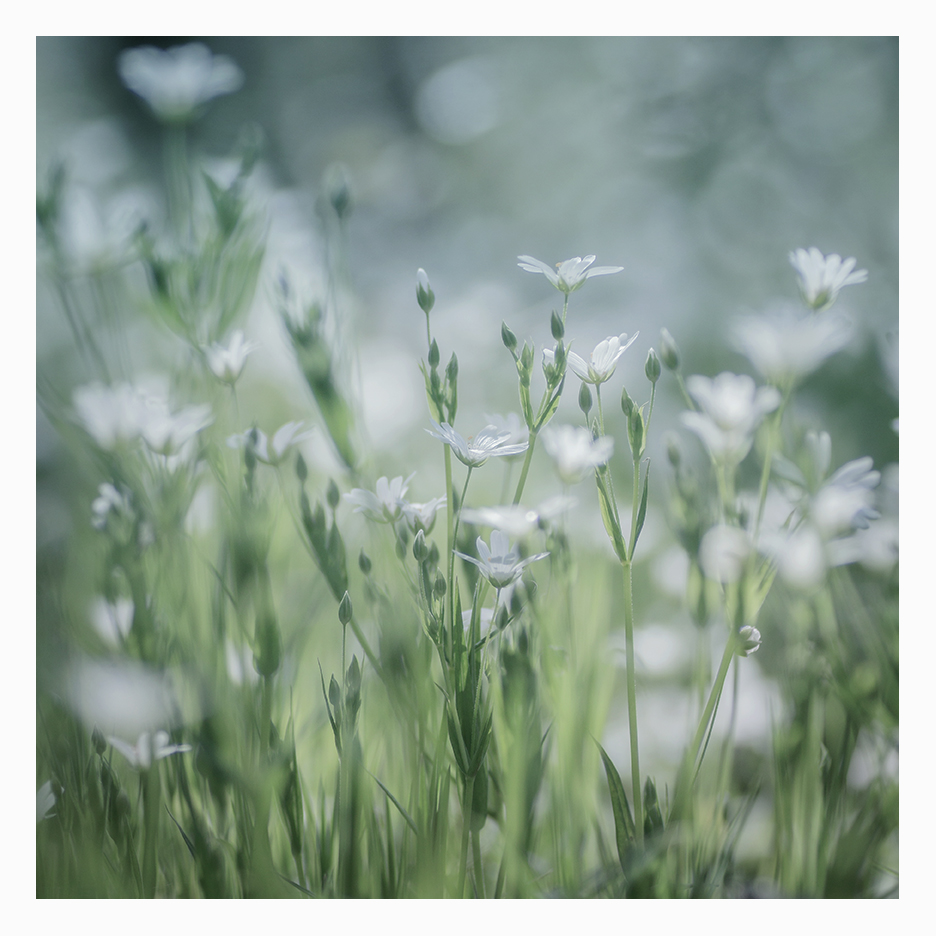
Lightroom
I will usually start editting any image in Lightroom. Below are a list of some of the adjustments I will usually make when shooting in the style outlined above. Of course this is a generalisation, but hopefully if you wee looking to create something similar it will be a help to you.
- Decreasing the vibrance significantly
- Decreasing highlights and the white levels
- Increasing the saturation of reds, oranges, cyan, blues and pinks
- Decrease the saturation of yellows and greens
- Decrease the luminance of cyan
- Applying split toning (usually with blues and browns)
- Sharpening with a mask of 70-90%
- Applying vignetting
- Adjusing exposure
Other useful tools are the adjustment brush for picking out fine details and the radial filter tool which I sometimes use to highlight areas of an image.
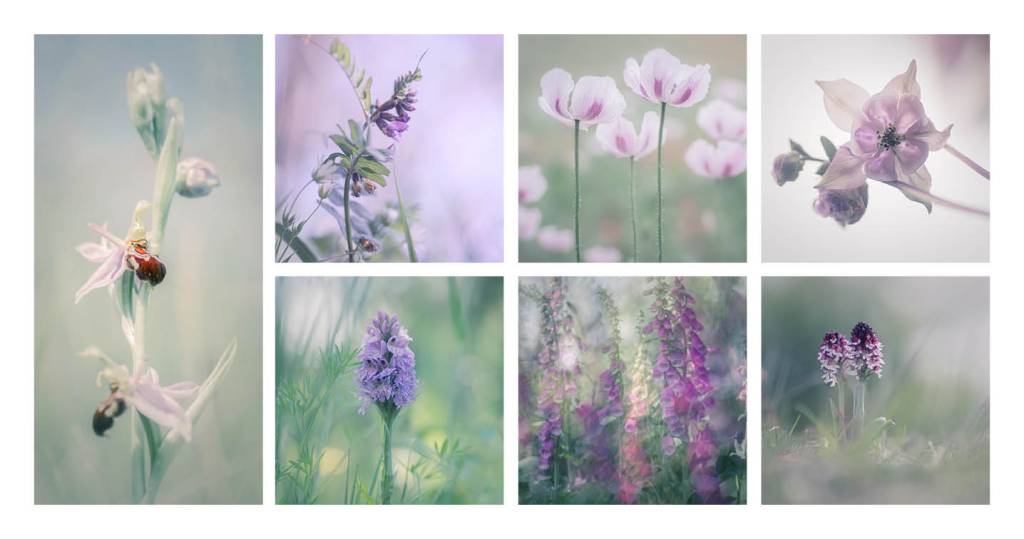
Photoshop
Here’s simple trick in Photoshop to give an ethereal feel to an image this works well for landscape and portraiture as well as macro, and can give a woodland a really fairytale feel.
- Open your image in PS.
- Make a duplicate layer of your chosen image.
- Apply a Gaussian blur to the duplicate layer (50-80%)
- Apply a curves adjustment layer to the duplicate layer and lift the top right part of the curve to lighten the blurred layer.
- Apply a cliping mask to the curves adjustment layer you just created (right click on the layer to see this option)
- Select the duplicate layer you made initially and move the opacity slider to between 15 – 30%
As you move the opacity slider you can see how this affects the ethereal quality of the picture. It is then possible, should you wish to pull parts of the image through using a mask or the eraser tool, or to just apply this effect to parts of your image.
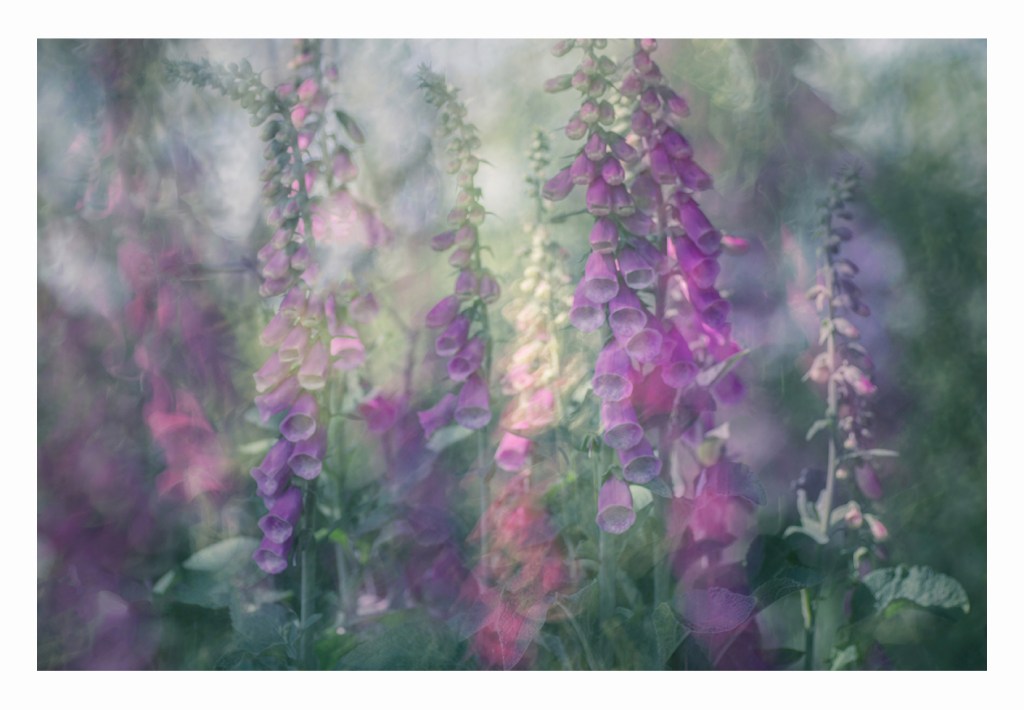
Multiple exposures and ICM
The foxglove image above uses another creative technique which I employ quite a lot, and that is to shoot an ICM (intentional camera movement) image and a still image of the same subject and then to combine them. As my camera won’t allow me to do this “in-camera” I imagine my finished image while shooting and then combine them in Photoshop later. This can be as simple or eleborate a process as you chose to make it, but in it’s most simple form, layer two images and with the top layer selected play with the blending modes and opacity settings on the right hand panel.
The image of oxeye daisies below has been made using the same pincipal. I will write more about multiple exposures and ICM photography in another post.

A final word of caution
Shooting on the woodland floor and in meadows will expose you to ticks. I am frequently bitten by them and have taken anti-viral medication for Lymes disease on a few occassions. Do make sure you are covered up, especially in long grass and where deer are present. Check yourself over when you leave a site. Use a tick remover to safely remove the little sods and if you have flu like symptoms or a bullseye rash or any concerns following a bite do seek medical advise.

Thank you
If you have enjoyed this blog and found it useful I’d be really grateful if you would consider buying a card (for less than the price of a coffee) at my online card shop, HERE. Or if you would like to share any images that you have taken I would love to see them. x
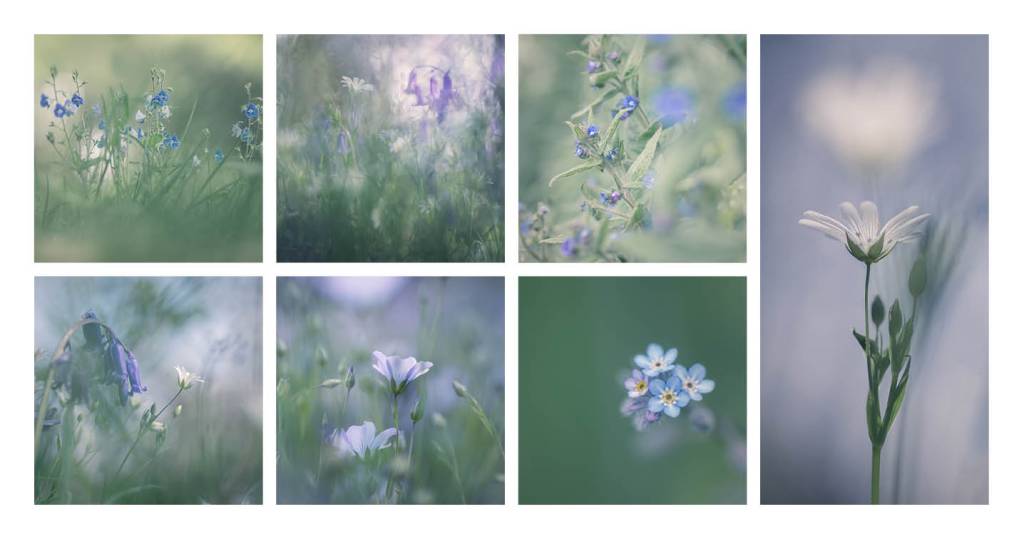
NB. I’ve just realised that I hadn’t mentioned ISO in this post. For anyone that may be interested I usually shoot at ISO 100. But occasionally, if the conditions are darker in a woodland setting perhaps I will adjust ISO up to a maximum of 400.
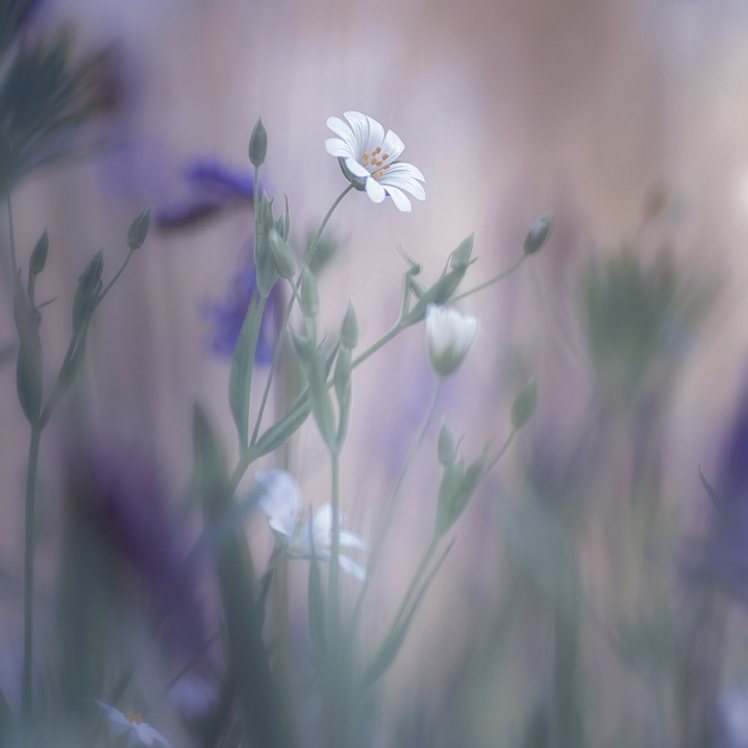
Hi Jo
Would love to read this…how do I get the password, please?
Francesca __________________________ Francesca Shearcroft M: 07595 154971 http://www.francescashearcroftphotos.co.uk
>
LikeLiked by 1 person
Thank you Francesca, it will be live by the end of the day, I’m just having it proof read as I have dyslexia. It always mortifies me to discover I’ve written things back to front. I hope you will enjoy it when it’s live. Best wishes, Jo.
LikeLike
Wonderful photos. Would be very interested in a workshop or 1-2-1 when they resume.
LikeLike
Thanks Denise, I’ll let you know when I resume these, it may be a little while due to the pandemic, but in the meantime I will be sure to add nline content via blog posts and perhaps other means. Best wishes, Jo.
LikeLike
Gorgeous photos and very well explained how you take them!
LikeLiked by 1 person
Thank you so much!
LikeLiked by 1 person
I love your images, Jo, and would be really interested in doing a 1:2:1 workshop when you begin to run these again. Thank you,
Geoff.
LikeLike
Thanks, Geoff, I hope to make some dates available in the Spring. Best wishes, Jo.
LikeLike
Thank you so much for the reasons you shoot this way and for allowing us to see how your images are created. I adore your images as you know. Look forward to catching up with you sometime!!
LikeLiked by 1 person
Thank you, Judith, I really appreciate your kind words. I would love to catch up, unfortunately I won’t be heading to Cropready this year, but when you are next in Dorset do send me a message. All the best to you and your family, stay safe & well .
LikeLike
Thank you Jo for your very informative blog as I have always admired your photography.
LikeLiked by 1 person
Thank you so much, Diane, I really appreciate your kind words.
LikeLike
Your explanation and rhythm of your words have a similar ethereal feel as your images. Your entire post was calming, inviting and enveloping. You have clearly found your muse and your unique signature for your art. Bravo!
LikeLiked by 1 person
Thank you so much, Glen, I really appreciate your kind and generous words.
LikeLike
Very well written and clearly explained, thank you. Some lovely images..Keep enjoying your woodland walks and photography.
LikeLiked by 1 person
Thanks so much, Ron, I’m so pleased you enjoyed the post. Best wishes, Jo.
LikeLike
I love your images and really appreciate you sharing your process. Thank you!
LikeLiked by 1 person
Thanks so much, Ruth!
LikeLike
Thank you so much for sharing this Jo – it’s beautifully written and a fascinating insight into your philosophy and techniques. Your work is so inspiring!
LikeLiked by 1 person
Thanks so much, Emma, that’s very kind.
LikeLike
Love your images – thank you for sharing.
LikeLiked by 1 person
Thanks so much for reading I’m glad you enjoyed the post.
LikeLike
Useful – thank you.
LikeLiked by 1 person
You’re welcome Adam 🙂
LikeLike
Hi Jo,
Really enjoyed reading your blog. I’m also dyslexic, but I go the opposite way and love the brightness of yellows and oranges. I do a lot of still life, I’m also a florist and sometime if we have flowers that are not so good I take home and have a play. Auto correct is great for being dyslexic but sometimes even that find the word I’m trying to find. 😂
LikeLiked by 1 person
Hi kerry, isn’t that funny? We’re all so different, As for auo-correct, much as I love it, very often it’s a week before I see it’s decided to use a wors I didn’t want it too but I’d not noticed. It terrifies me writing important emails, I have to reread them so many times! haha
LikeLike
I love the images and the explanations- it all has a very calming effect- including your words!
LikeLiked by 2 people
Thanks so much, Carmen. 💚
LikeLike
What a wonderful blog post. I am so grateful for your kind generosity in sharing your knowledge. Your images are exactly what I like to do, but mine lack the finesse of yours. I shall be practicing using your guidance. Once again, thank you so much ❤
LikeLiked by 1 person
Thank you Linda, I’m so pleased that you have found it useful. Sharing my photography is how I connect with people, and it gives me great joy. Answering some questions and sharing some knowledge is a fitting thank you for all the positive feedback I’ve had on my work over the years. Have a wonderful time with your camera.
LikeLike
Congratulations, beautiful pictures. And very rare to find an artist who explains his technique so well and who agrees to do so. Very inspiring
LikeLiked by 1 person
Thank you, that’s very generous of you. Its a pleasure to share, I hope my post may inspire some people to spend some healing time in their local green spaces and to share imagery of nature. Best wishes, Jo.
LikeLike
Thank you so much Jo for a beautifully clear explanation and for sharing your expertise. Your photos are amazing
Krys
LikeLiked by 1 person
Thank you so much, I’m so happy you like my work and I hope if you put any of the tips in to practice they are helpful. Best wishes, Jo
LikeLike
You have a wonderful eye for the composition of your photographs and a very natural touch when it comes to adjustments. Thank you for being so open about your working method.
LikeLiked by 1 person
Thank you, Robert, that’s so kind. Its a pleasue to share if it helps other people create the images they want to and of course enjoy all the benefits of spending time in nature.
LikeLike
Jo, Thank you so much for sharing your images & processing techniques. the images are so awesome, surreal & absolutely beautiful
LikeLiked by 1 person
Thank you, Jenny, that’s such a beautiful and kind thing to say. Best wishes, Jo.
LikeLike
Trust me Jo, you don’t need a better kit! For me, photography is about ‘seeing with soul’ and the artistry to create. You do that beautifully. Some people could spend thousands on the latest gear and never come close to what you do. Thank you for sharing.
LikeLiked by 1 person
Thank you, Jo, that’s the most beautiful compliment and your words mean so much to me. Thanks so much.
LikeLike
Thank you Jo. Beautiful images and grand information.
LikeLiked by 1 person
I’m delighted you enjoyed it and found it useful, thank you Jill.
LikeLike
Thank you so much for this post I have been following you on Twitter for some time and have always wondered how you get your beautiful images. I live in the same area as you and probably go to the same woods but mine are always ‘straight’ images not your gorgeous dream like pictures. After reading this I’m going to have a go and if they are 1/4 as good as your I will be pleased.
LikeLiked by 1 person
Thank you for your lovely words, Marilyn, and how wonderful we are local to each other. Its a beautiful part of the world. I’m really pleased that you found the blog useful and hope it helps you to create some deamy images of our beautiful countryside. Perhaps we’ll bump into each other in the woods one day! My best wishes, Jo.
LikeLike
I was inspired by your experience!! Thanks a lot for sharing and making me realize how much insight I should invest in every shot, before making it. I’m so hasty to catch a unique moment that it often destroys my work. You teach how to refer to photography as to a meditation practice, to dissolve the ego and connect to a universal consciousness. You have put it in a great way, thank you!
LikeLiked by 1 person
Thank you Marina, I’m so pleased you found the post interesting and useful. Of course sometimes there is nothing for it but to shoot in haste, especially with butterflies on the wing, but even then you can lose yourself as you watch them. 🙂
LikeLike
Really beautiful work Jo, love it. I’ll be following you on social media. I’m known as Garden Imagery.
LikeLike
Thanks so much, Kathie,
LikeLike
It is extraordinarily generous of you to share this information. I have been so inspired by your images and learned a lot reading this post. Thank you so much.
LikeLike
You are very welcome, Finola, I am so pleased you have enjoyed the post and found it to be of value. I wish you many happy hours in nature capturing its beauty.
LikeLiked by 1 person
I love your photo’s and often use one of your carss for special occasions.
I’m going to try some of yourmtechniques for my ICM images.
What would be your dream camera if you absolutely had to replace your Sony?
LikeLike
Thank you so much, Joan, I’m so pleased you’re going to try out soe of my tips. And oh, theres a question! I really don’t know as I’ve never really tried any other cameras. I think I’d like to experiment with in camera ME and I do like the mirrorless systems so maybe a Canon EOS R, or the Fuji XT4 I’m also curious about the Olympus E-M1 Mark III. What camera(s) do you shoot with?
LikeLike
My dslrs are Nikon and because I’m getting old and creaky they’re getting heavy.
I’ve tried just about every make of camera, I loved the Fuji XT1 but the nicest lenses for that
are heavy. I sold that when the Nikon Z50 came in last year but now I have to wait for them to bring out new lenses to fit. Its so new Sigma and Tamron don’t make z mount lenses yet.
I have an adapter for the nikonf lenses I own but they add weight.
I’ve just bought a Panasonic fz 82, as a walk around camera, it’s so light weight. Maybe I’ll lose sharpness but for ICM that really doesnt matter.
I buy most stuff from the second hand people like MPB or Ffordes.
Have you asked any camera companies about sponsering you. Some have Ambasadors and it might be worth a try.
LikeLike
Thank you so much for sharing, I somehow stumbled on this and I am very glad that I did
LikeLiked by 1 person
Very inspirational and lovely photographs.
LikeLiked by 1 person
Thank you, that’s very kind.
LikeLiked by 1 person
I am a huge fan of your work. Thank you for sharing what you do. I didn’t know you sold cards, so I have bought some!
LikeLike
Hi Jo, I admire your photography so much. Your write up was extremely informative, and very true. Walking with nature, breathing it all in is the reason i love photography. Wonderful blog that I am gradually working my way through. You are a true inspiration
LikeLiked by 1 person
Thanks so much, Alex, that’s enormously kind and much appreciated. X
LikeLike
I disagree when you say that you think you would get better results with better kit, I think your images are crazily perfect. Thank you for the explanation. I can only dream to aspire to the level of beauty that you achieve. As for the ticks, yes me too, now it’s trousers tucked into socks, but apparently when quickly removed, you are less likely to be infected. Best wishes
LikeLike
wonderful photos…and thanks so much for including editing info etc!
LikeLiked by 1 person
You’re very welcome, thank you!
LikeLike
Hi Jo, I loved this article so much I purchased all your cards. I cherish each and every one of them. Thank you.
LikeLike
Thank you so very much, Simone. I am so delighted you enjoyed the post and humbled that you cherish the cards. Thank you.
LikeLike
Your photos are such an inspiration!!! Thank you for all your information!!!
LikeLike
Such beautiful images and so inspiring! Thank you for sharing this with us!
LikeLiked by 1 person
It’s my pleasure, thank you so much.
LikeLike
Thank you for this great article!
the information shared is really helpful. Known About us Click here
clickerhelp
LikeLiked by 1 person
Thank you
LikeLike
Thank you Jo for sharing your expertise with us. It’s obviously a technique you’ve perfected over time and the results are stunning. I’m really inspired to have a go and see what I can come up with. Thank you again.
LikeLiked by 1 person
Thank you so much for your kind comments. Wishing you the best with your experimentation 🙂
LikeLike
Thank you once again. Stunning images. Fascinating insights. Feeling inspired.
LikeLike
Thank you for sharing these beautiful images Jo, and to tell us how you approach your post processing
LikeLike
Your images are stunning but your honestly and generosity in sharing your technique struck me as well.
LikeLiked by 1 person
Thank you so very much, Bonnie
LikeLike
Thank you so much for directing me to your blog Jo, your work is beautiful. If I could create one image half as good as any one of yours, I would be a very happy lady. In the meantime, I shall purchase one of yours to hang on my wall. Are you doing 1-2-1 workshops yet?
LikeLike
Beautful images and such a generous sharing of your techniques. Thank you.
LikeLike
Thank you Jo for an excellent blog . I will get out to try some of your techniques ……
LikeLike
Great job Joe Stephen!
I used to create my impressionistic work, on location on film without any help of post processing, but in the absence of the chemical process of digital photography – I need getting assistance of photoshop to achieve a similar look
thank you for sharing
Dubi Roman
dubiroman.com
LikeLike
This is really appreciated that you have presented this data over here, I love all the information shared. It will be very helpful to understand the content on drone photography ideas and tips . Indeed a great post to share!! Loved it.
LikeLike
Good job always love nature God Blessing with us always
thanks parmesh kumar
LikeLike